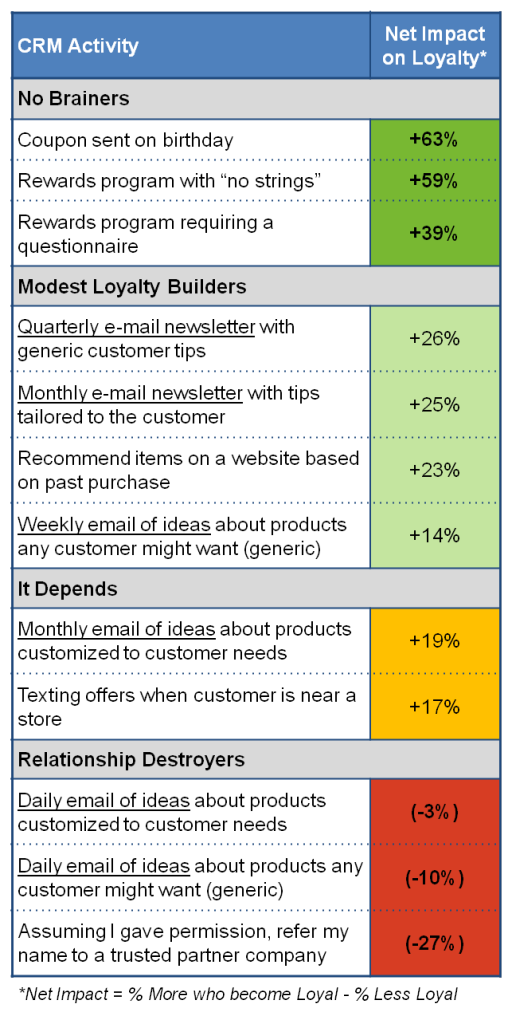Most service-driven businesses, and even non-profits, possess a trove of data about customers that can drive CRM tactics to increase sales and loyalty. These tactics may include generic messages, tailored messages, special offers and loyalty rewards programs. Besides a short-term lift in sales, a CRM strategy should build loyalty in the long run. As companies bombard consumers with electronic communication such as email, websites and texting, a question arises – is there a downside to using customer information to build loyalty?
Field experiments (A/B tests) may shed some light on the impact of CRM tactics, but a survey approach has the advantage of telling us how consumers feel about different activities. In light of increasing concerns about the use of customer information by marketers, we included topics in our most recent National Technology Readiness Survey (February 2014) to examine how different CRM approaches impact customer loyalty. For  several activities, we determined the net impact on loyalty by asking consumers if a particular activity made them “more loyal,” “less loyal,” or “had no impact”. We also assessed the impact of frequency of communication, tailored versus generic content, and differences by age.
several activities, we determined the net impact on loyalty by asking consumers if a particular activity made them “more loyal,” “less loyal,” or “had no impact”. We also assessed the impact of frequency of communication, tailored versus generic content, and differences by age.
 The No Brainers: Some activities clearly build relationships because they are viewed positively by consumers but have minimal negative impact on loyalty. This includes a coupon to wish a customer a “happy birthday,” a rewards program with special discounts just for signing up, and to a lesser extent, a rewards program that requires the customer to fill out a questionnaire.
The No Brainers: Some activities clearly build relationships because they are viewed positively by consumers but have minimal negative impact on loyalty. This includes a coupon to wish a customer a “happy birthday,” a rewards program with special discounts just for signing up, and to a lesser extent, a rewards program that requires the customer to fill out a questionnaire.
Relationship Destroyers: At the opposite end of the spectrum, some activities can actually harm customer loyalty. The cardinal sin is referring a customer’s contact information to a “trusted partner,” even when the action is framed by the disclaimer “assuming I gave permission.”  Consumers may be skeptical of how careful companies will be in prominently disclosing when permission has been given and what that permission entails; in other words, clicking “I agree” may be a deal with the devil. Another way to destroy a relationship is to bombard customers with daily emails about products and services. Field testing may register declining click and open rates, but the long term impact on loyalty may be not just “zero” but negative. Today’s consumers experience a huge volume of “grey SPAM,” or unwanted email where there is a plausible connection to the sender, making it possible to annoy customers with too much of a good thing.
Consumers may be skeptical of how careful companies will be in prominently disclosing when permission has been given and what that permission entails; in other words, clicking “I agree” may be a deal with the devil. Another way to destroy a relationship is to bombard customers with daily emails about products and services. Field testing may register declining click and open rates, but the long term impact on loyalty may be not just “zero” but negative. Today’s consumers experience a huge volume of “grey SPAM,” or unwanted email where there is a plausible connection to the sender, making it possible to annoy customers with too much of a good thing.
 Age Matters: The age of the customer may make a difference on how an activity impacts loyalty, though not necessarily in the way we might expect. Predictably, younger consumers are more predisposed to receiving text messages with discount offers when they are near a store, but this action has a net negative impact among older consumers. Yet, older consumers are more positive towards receiving online newsletters with useful tips.
Age Matters: The age of the customer may make a difference on how an activity impacts loyalty, though not necessarily in the way we might expect. Predictably, younger consumers are more predisposed to receiving text messages with discount offers when they are near a store, but this action has a net negative impact among older consumers. Yet, older consumers are more positive towards receiving online newsletters with useful tips.
Sensitivity is Important: A final observation worth noting is that there tends to be a faction of customers – about a sixth of the population – who resent their information being used to entice them to buy more. When collecting and using information such as email and purchase behavior, it is critical for companies to respect the customer’s privacy by providing prominent and user-friendly ways to opt out.
The bottom-line is that customers are appreciative of electronic marketing that offers them a tangible reward or useful information. However, a good thing can become a bad thing if the marketer is not mindful of who, how and when a tactic occurs.
Written by: Charles Colby, Chief Methodologist
